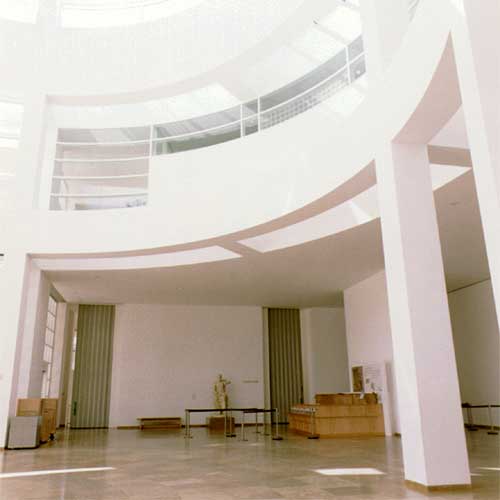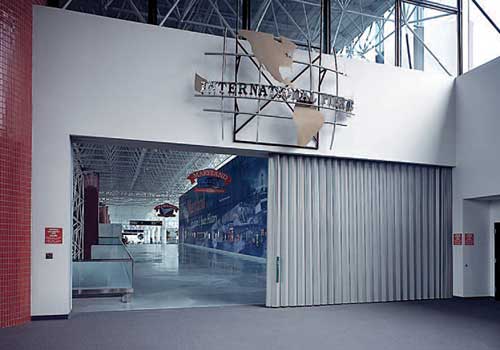Horizontal Sliding Fire Doors: Catalyst for Architectural Versatility
Design Possibilities
By allowing openings to appear unencumbered, sliding door systems provide practical answers to fire and egress code requirements while allowing extraordinary architectural versatility. Many museum architects have determined that horizontal sliding door systems solve the problem of meeting fire and building codes while maintaining open vistas between large vertical and horizontal internal spaces. For the Bilbao Guggenheim Museum, Gehry Partners used 10 fire-rated horizontal accordion style sliding doors totaling 3,000 sq ft to deliver interior spaces that aptly reflect the dramatic forms of the exterior. For the J. Paul Getty Museum at the Getty Center in Los Angeles, Richard Meier and his firm Richard Meier & Partners specified 64 doors or over 6,600 sq ft of sliding doors as invisible fire breaks that allow people to move freely between the exhibition spaces.
 |
Unlimited openings in this museum were possible through the use of Photo courtesy of Sutton Photography |
Â
Sliding door systems have a range of applications in a multitude of building types. Some serve several code compliance functions at once such as providing exits and protecting vertical openings, elevator lobby separations and remote security monitoring capabilities plus permitting multi-level fire rated design features. In sum, they provide "area separation," a reference much in use but now outdated as a code term. Applications for code compliance include:
- Fire Wall Separation
- Fire Barriers
- Shaft enclosures
- Fire Partitions
- Smoke Partitions
In high-rise buildings, sliding fire door systems are often the least expensive means of separating the elevator lobby from the remainder of the building and to provide egress doors as required by code. Sliding fire doors can maximize the opening into the elevator lobby and minimize any design constraints associated with accommodating doors swinging into the elevator lobby or encroaching on exit corridors.
Sliding door systems are found in Marriott, Hyatt, Walt Disney World, Ritz Carlton and Hilton hotels. They also provide for open and easy accessibility to the gaming floors in many Las Vegas hotels. Caesar's Palace, for instance, has a concealed specially engineered 32-ft 7-in high 1-1/2-hour sliding fire door separating the multimillion dollar Roman Forum shopping mall from the casino's main gaming area (noting the heavy track system and proposed construction modifications, UL issued an oversized special door certificate).
Sliding doors deliver spaciousness and open access in megaplexes, as well as providing fire separation walls required to compartmentalize the area. Some sliding fire-door systems in shopping malls and sports facilities reach 100-feet in width when open. At the other end of the spectrum, sliding door assemblies have been used at the entrance of parking garages where there was insufficient height for a typical roll down fire shutter.
Typical Features of Horizontal Sliding Door System |
1. Exiting hardware 2. Leading edge obstruction detector 3. Leadpost (not pictured) 4. Single- or bi-parting doors (not pictured) 5. Pocket cover door (not pictured) 6. Track and trolley system 7. Thermal lockout feature 8. Microprocessor monitoring 9. Power supply 10. Floor gasket and fire liner 11. Modular design |
 Photos courtesy of Alan Wood |
Â
In addition to being fire code compliant, sliding door systems offer security against break-ins. In one California shopping mall, burglars succeeded in breaking through traditional roll down gates, but their crowbars failed to dislodge the steel sliding door assembly installed in a fire separation upgrade at the entrance to the mall.
 |
Sliding doors keep airport corridors open for moving travelers but will Photo courtesy of Michael Dersin Photography |









